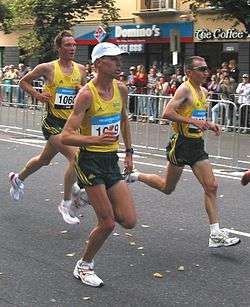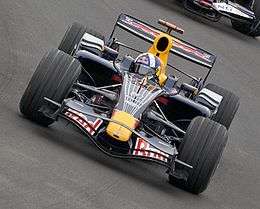Tower running
Tower running is a sport which involves running up tall man-made structures. Usually the races take place on the internal staircases of skyscrapers, but the term can cover any foot race which involves a course that ascends a man-made structure.
Tower running races often take place at the world's tallest structures, including Taipei 101 (Taipei), Menara Tower (Kuala Lumpur), Willis Tower (Chicago), CN Tower (Toronto), Eiffel Tower (Paris) Eureka Tower (Melbourne), Swissotel (Singapore), Tower 42 (London), the Empire State Building (New York), the Bitexco Financial Tower (Ho Chi Minh City), and the Colpatria Tower (Colombia). Races are held in either time trial or mass-start format and attract elite athletes from various sports often with large sums of prize money.
The results of more than 160 races on all continents are evaluated each year for the Towerrunning World Cup. The most important - about 15 so called "Masters Races" - have a predefined factor of 1.5 to 4, whereas all other races are given 0.5 or 1 depending on class and internationality of the participants.
2015 saw the inaugural World Championship in Doha, Qatar, with Andrea Mayr (AUT) and Piotr Łobodziński (POL) crowned champions. The 2018 World Championship was held on 5th May at Taipei 101 in Taiwan. Piotr Łobodziński (POL) retained his title, while Suzy Walsham (AUS) won the ladies division.
History
The first recorded stair race was held on Bastille Day (14 July) 1903 in Paris. Organised by a publication called Revue Sportive, the event took place on the steps of the famous Rue Foyatier in the 18th arrondissement of the city.[1]
In 1905 the first known tower race was held at the Eiffel Tower. It took place on Sunday 26 November and was organised by a publication called Les Sports. The magazine’s aim was to pit champions and elite athletes from various sporting traditions against each other in the ultimate test of fitness. Runners, cyclists, footballers plus amateurs were all among the 283 people who took part in the first ever tower race.[2]
The event was repeated again in 1906, but following that race it would be 109 years before stair climbing returned to the Eiffel Tower again, with the first edition of La Verticale de la Tour Eiffel in 2015.
In 1968, the sport made its debut in the United Kingdom. Teams from the University of London and the University of Edinburgh went head-to-head at the BT Tower in London, with the Edinburgh team taking victory.[3] That inter-university event was repeated in 1969 and 1970, after which there were years of inactivity for the sport in the UK.
Tower running made its debut in the United States in 1978, when Fred Lebow organised the first Empire State Building Run Up (ESBRU). The ESBRU event has run every year since, and is the longest continuously running stair racing event in the world.[4]
Several more races popped up in the USA and around the world throughout the 1980s and the sport has been slowly growing since.
Participants
Leading international stair runners include:
- Men
- Piotr Łobodziński (POL), current world champion
- Christian Riedl (GER)
- Frank Nicolas Carreno (COL)
- Stefan Stefina (SVK)
- Mark Bourne (AUS)
- Shaun Stephens-Whale (CAN)
- Sproule Love (USA), cross-country skier.
- Justin Stewart (USA), Track athlete and fitness instructor.
- Thomas Dold (GER), world champion running backwards.
- Marco De Gasperi (ITA), world champion mountain running.
- Matthias Jahn (GER), European x-country runner.
- Gustavo Isaac Mendoza (MEX) Youngest athlete to be in the top 10 of the world ranking.
- Javier Santiago (MEX)
- Jorge Olivares Cabrera (MEX)
- Women
- Suzy Walsham (AUS), reigning world champion, world number one, former Commonwealth Games 1,500m finalist.
- Zuzana Krchova (CZE)
- Lenka Svabikova (CZE)
- Alice McNamara (AUS)
- Cindy Harris (USA)
- Kristin Frey (USA)
- Andrea Mayr (AUT), mountain running champion.
References
- ↑ https://towerrunninguk.com/2017/03/06/le-championnat-de-lescalier-1903-the-first-ever-stair-race-2/
- ↑ https://towerrunninguk.com/2017/03/15/the-origins-of-la-verticale-de-la-tour-eiffel/
- ↑ https://towerrunninguk.com/2018/02/17/gpo-tower-race-1968-celebrating-50-years-of-uk-tower-running/
- ↑ https://towerrunninguk.com/2017/02/03/thefirstempirestatebuildingrunup/
External links
- What is tower running and why are loads of people racing up skyscrapers? (The Irish Examiner)
- A step up – what is it like tower-running up a 35-storey building? (The Guardian)
- The very tall buildings where people run up the stairs for fun – and you can too (Independent.ie)
- TowerRunning.com
- Vertical World Circuit website
- Tower Running UK
- Stair Life - USA stair climbing website

